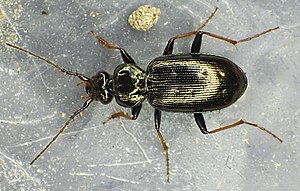Loricerinae
| Loricerinae | ||||||||||||
|---|---|---|---|---|---|---|---|---|---|---|---|---|

Black Krummhorn beetle ( Loricera pilicornis ) |
||||||||||||
| Systematics | ||||||||||||
|
||||||||||||
| Scientific name | ||||||||||||
| Loricerinae | ||||||||||||
| Bonelli , 1810 |
The Loricerinae are a subfamily of the ground beetles (Carabidae). 10 species of two genera are known worldwide. One species occurs in Europe, another on Madeira Island.
features
Beetle
The Loricera species look similar to medium-sized species of the genus Agonum of the subfamily Platyninae . The antennae have a long scapus and are provided with very long, upright hair on the pedicellus and the third to sixth links. The wing covers have 12 longitudinal furrows, but without a shortened furrow at the wing cover seam . The species reach a body length of approx. 6 to 9 millimeters.
Larvae
The head capsule of the larvae is rounded at the side. The antennae are twice as long as the sickle-shaped mandibles . The galea is directed from the stipes at right angles to the center. It is longer than the maxillary palps and the last limb is thickened at the base and finely granulated and otherwise drawn out like a riding crop. This distal part is covered by a transparent secretion. The labial palps are slender. Pro- , meso- and metanotum have split, flat-lying hairs, which distinguishes the larvae from those of the tiger beetles (Cicindelinae), which have this hair on the head and pronotum. The legs are long, the tarsi are elongated.
Way of life
The species of the genus Loricera are more or less water-loving. Due to their modified antennae or maxillae, both the adults and the larvae are characterized by their own prey capture method. They hunt springtails .
Systematics and distribution
The genus Loricera includes nine holarctic species. Two species reach the mountains of Central America, south to Guatemala. The only western Palearctic, and thus also European, species is Loricera pilicornis , which is circus arctic, also in North America. The genus Elliptosoma recorded in Madeira is monotypic and includes only the species Elliptosoma wollastoni , it is considered by other authors as a subgenus of Loricera . All Subtaxa and the European species are listed below:
- Loricerini tribe
-
Elliptosoma
- Elliptosoma wollastoni (Javet, 1852)
-
Loricera
- Loricera pilicornis (Fabricius, 1775)
-
Elliptosoma
Fossil species
From the Baltic amber , an imaginal beetle (described as Loricera groehni ) and a well-preserved larva (described as Loricera electrica ) have become known. The great similarity of the fossil finds to the recent species suggests that the morphology has not changed much for a long time. The adult beetle is more similar to species that are only found in East Asia today.
supporting documents
Individual evidence
- ↑ a b c d e Rolf G. Beutel, Richard AB Leschen: Handbuch der Zoologie - Coleoptera, Beetles, Volume 1: Morphology and Systematics (Archostemata, Adephaga, Myxophaga, Polyphaga partim) . 1st edition. de Gruyter , 2005, ISBN 3-11-017130-9 , p. 132 f . (English).
- ↑ Loricerinae. Fauna Europaea, accessed July 23, 2010 .
- ↑ Ross H. Arnett, Jr., Michael C. Thomas: American Beetles, Volume I: Archostemata, Myxophaga, Adephaga, Polyphaga: Staphyliniformia. CRC Press, Boca Raton etc., 2000. ISBN 0-8493-1925-0 . on page 72.
- ↑ Cai, C., Liu Y. & Huang, D. (2017): A new species of Loricera Latreille from Eocene Baltic amber (Coleoptera: Carabidae: Loricerinae). Alcheringa 41 (3): 315-320.
- ↑ Bernhard Klausnitzer (2003): Beetle larvae (Insecta, Coleoptera) in Baltic amber - possibilities and limits of determination. Entomological Treatises 61 (1): 103-108.
literature
- Rolf G. Beutel, Richard AB Leschen: Handbuch der Zoologie - Coleoptera, Beetles, Volume 1: Morphology and Systematics (Archostemata, Adephaga, Myxophaga, Polyphaga partim) . 1st edition. de Gruyter , 2005, ISBN 3-11-017130-9 (English).